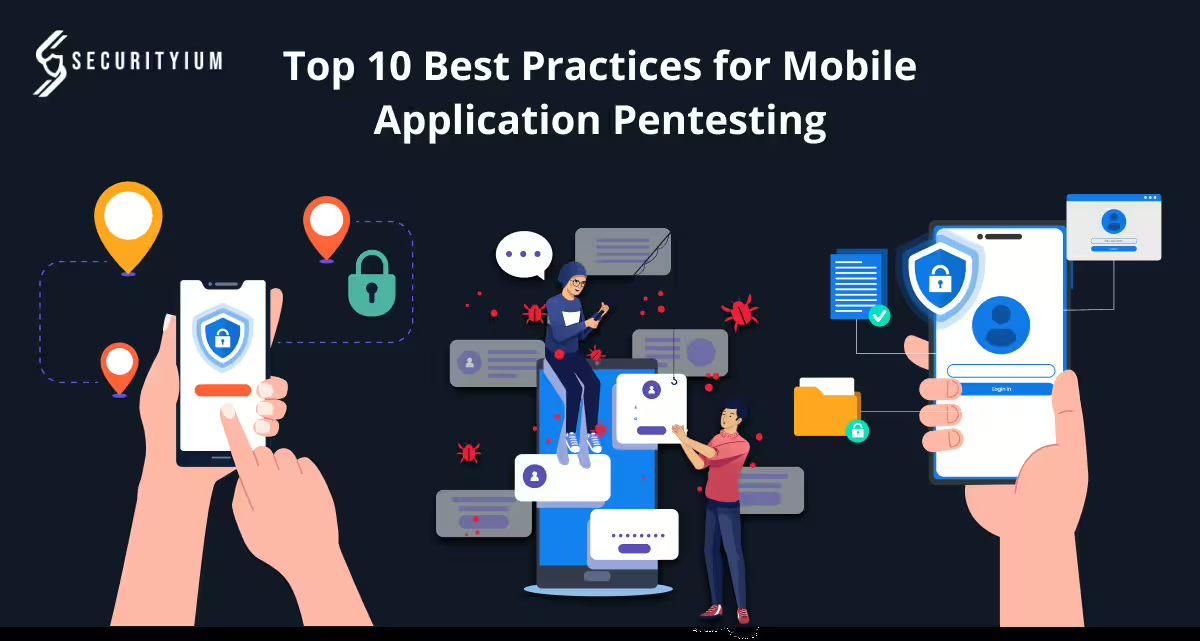
Oct 22, 2024 Information hub
Top 10 Best Practices for Mobile Application Pentesting
Mobile Application Penetration Testing (MAPT) is essential for ensuring the security and integrity of mobile apps, particularly for iOS and Android platforms. Below are ten best practices that cybersecurity professionals follow when performing pentesting for mobile apps.
1. Understand the Application’s Architecture
- Review Platform and Frameworks:
- Identify whether the app is built using native frameworks (e.g., Swift for iOS, Java for Android) or hybrid ones (e.g., React Native, Flutter).
- This step helps in tailoring the testing approach based on the platform-specific vulnerabilities.
- Assess the Backend and APIs:
- Mobile apps often rely on APIs for server-side communication. Make sure to map out the API endpoints for testing.
Tip: Always begin with a detailed threat model based on the app’s architecture to identify potential weak points before starting the actual testing process.
2. Static Application Security Testing (SAST)
- Review Code for Vulnerabilities:
- Test the app’s source code or decompiled code without running it to detect vulnerabilities like hardcoded credentials, weak encryption, or improper API calls.
- Tools:
- Focus on Reverse Engineering:
- Ensure the app is not easily reversible to protect against code tampering and intellectual property theft.
Tip: Regularly update your static analysis tools and rulesets to ensure they cover the latest mobile app security vulnerabilities and coding standards.
3. Dynamic Application Security Testing (DAST)
- Test the App in Real-Time:
- Dynamic testing involves running the app to observe real-time behaviors, such as how it handles inputs, processes data, and interacts with the server.
- Look for Business Logic Flaws:
- Ensure that critical workflows, like authentication and payment gateways, are secure and free from logical flaws.
- Use Proxy Tools:
- Tools like Burp Suite can help intercept app traffic, enabling you to test for man-in-the-middle (MITM) attacks.
Tip: Simulate different network conditions (e.g., poor connectivity or public Wi-Fi) to see how the app behaves in diverse environments during dynamic testing.
4. Check for Insecure Data Storage
- Inspect Local Storage:
- Examine whether sensitive information (e.g., passwords, tokens) is stored in plain text within the device’s file system or databases.
- Test for SQL Injection:
- If the app uses a local database (e.g., SQLite), check for vulnerabilities like SQL injection, where an attacker can manipulate queries to access data.
Tip: Always check the app’s backup files and cache, as sensitive data can sometimes be unintentionally stored in these locations.
5. Evaluate Network Communication Security
- Test SSL/TLS Implementation:
- Ensure Secure Sockets Layer (SSL) and Transport Layer Security (TLS) protocols are properly implemented to secure communication between the app and server.
- Check for Certificate Pinning:
- Test if the app correctly pins SSL certificates to prevent MITM attacks.
- Validate HTTPS:
- Ensure all communication is encrypted and no sensitive data is exposed in transit.
Tip: Disable any fallback to non-encrypted HTTP communication during testing to ensure that the app only transmits data over secure HTTPS.
6. Authentication and Authorization Testing
- Test Login Mechanisms:
- Try common attacks like brute force or credential stuffing to see if you can break into the app.
- Verify Session Management:
- Ensure that user sessions expire correctly and cannot be hijacked. Check for vulnerabilities like session fixation.
- Test Privilege Escalation:
- Look for instances where lower-privileged users can access higher-privileged actions or data.
Tip: Test how the app handles failed login attempts and ensure there’s an account lockout mechanism after a defined number of unsuccessful attempts to prevent brute force attacks.
7. API Security Testing
- Evaluate API Endpoints:
- Test the security of backend APIs for vulnerabilities like improper authentication, insufficient encryption, and data leakage.
- Input Validation:
- Ensure that APIs properly validate and sanitize input data to prevent injection attacks.
- Check for Rate Limiting:
- Confirm that APIs enforce rate limits to protect against Denial of Service (DoS) attacks.
Tip: Use automated API fuzzing tools to stress test the app’s backend for unexpected behavior and vulnerabilities that may not surface during manual testing.
8. Check for Insecure Cryptographic Practices
- Test Encryption of Sensitive Data:
- Ensure that sensitive data (e.g., passwords, payment info) is properly encrypted using strong algorithms (e.g., AES-256).
- Avoid Deprecated Cryptography:
- Ensure that outdated or weak algorithms (e.g., MD5, SHA-1) are not used.
- Test Key Management:
- Check how encryption keys are managed and stored to prevent exposure.
Tip: Ensure that random keys are generated using secure pseudo-random number generators (CSPRNG) to avoid predictability in encryption algorithms.
9. Test for Client-Side Injection Attacks
- Focus on Input Fields:
- Inspect input fields for vulnerabilities like Cross-Site Scripting (XSS), where attackers inject malicious scripts.
- Test for SQL and NoSQL Injections:
- Ensure that database queries (both SQL and NoSQL) are protected from injection attacks by sanitizing inputs.
- Tools:
- Tools like OWASP ZAP can be used to automate some injection testing.
Tip: Always check how the app handles error messages and exceptions, as poorly managed error responses can reveal sensitive system information to attackers.
10. Comprehensive Reporting and Remediation
- Detail Vulnerabilities:
- Provide a clear and concise report that outlines the vulnerabilities, their severity, and their impact on the app’s security.
- Remediation Recommendations:
- Offer actionable advice on how developers can fix the vulnerabilities found during pentesting.
- Retest:
- Once vulnerabilities are fixed, a retest should be performed to ensure that the patch works as intended and doesn’t introduce new issues.
Tip: When reporting vulnerabilities, prioritize issues based on their potential impact and exploitability, offering clear, step-by-step remediation actions for developers.
By following these best practices, you can ensure a thorough and effective mobile application penetration test. Regular testing and staying updated on new threats will help keep mobile applications secure against evolving cyber risks.
